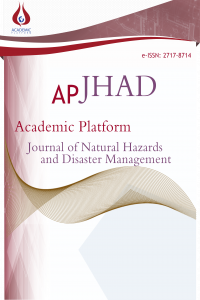The Effect of Different Soil Classes on Earthquake Demands of Reinforced Concrete Structures: Case Study for Sakarya
Soil class, Turkish Building Earthquake Code 2018, Reinforced-concrete frame, Base shear, Structural demands
The Effect of Different Soil Classes on Earthquake Demands of Reinforced Concrete Structures: Case Study for Sakarya
Soil class, Turkish Building Earthquake Code 2018, Reinforced-concrete frame, Base shear, Structural demands,
___
- [1] Z. Celep, Deprem Mühendisliğine Giriş ve Depreme Dayanıklı Yapım Tasarımı. Istanbul: Birsen Yayınevi, 2019.
- [2] The Ministry of Environment, Urban and Climate Change. “Turkish Building Earthquake Code, TBEC 2018.” Turkey, 2018.
- [3] K. Darılmaz, Depreme Dayanıklı Binaların Tasarımına Giriş. Istanbul: Birsen Yayınevi, 2019.
- [4] T., Uçar, O. Merter. (2012, Dec.) “Binaların deprem hesabında kullanılan doğrusal elastik hesap yöntemleriyle ilgili bir irdeleme.” Ordu Üniversitesi Bilim ve Teknoloji Dergisi. 2 (2), pp. 15–31. Available: https://dergipark.org.tr/tr/download/article-file/113887
- [5] V., Başaran, M. Hiçyılmaz. (2020, June) “Betonarme çerçevelerde farklı deprem yer hareketi düzeyi etkilerinin incelenmesi.” Journal of Innovations in Civil Engineering and Technology. 2 (1), pp. 27–41. Available: https://dergipark.org.tr/tr/download/article-file/1176258
- [6] M. Fragiadakis. (2013, Jan.) “Response spectrum analysis of structures subjected to seismic actions.” Encyclopedia of Earthquake Engineering. pp. 3–18. Available: https://link.springer.com/referenceworkentry/10.1007/978-3-642-36197-5_133-1
- [7] A. Doğangün, Deprem-Zemin ve Depreme Dayanıklı Yapı Tasarımı. Istanbul: Birsen Yayınevi, 2021.
- [8] E. Canbay, U. Ersoy, G., Özcebe, H. Sucuoğlu, T. S. Wasti, Binalar için Deprem Mühendisliği Temel İlkeler. Istanbul: Bizim Büro Basımevi, 2008.
- [9] M.N., Aydinoglu. (2003, Jan.). “An Incremental Response Spectrum Analysis Procedure Based on Inelastic Spectral Displacements for Multi-Mode Seismic Performance Evaluation.” Bulletin of Earthquake Engineering. (1), pp. 3–36. Available: https://link.springer.com/article/10.1023/A:1024853326383
- [10] A.K. Chopra, R.K. Goel, Modal pushover analysis of sac buildings. California: PEER, 2001.
- [11] A.K., Chopra, R.K., Goel. (2002, Dec.). “A Modal Pushover Analysis Procedure for Estimating Seismic Demands for Buildings.” Earthquake Engineering Structural. Dynamics. (31), pp. 561–582. Available: https://onlinelibrary.wiley.com/doi/10.1002/eqe.144
- [12] M.J.N. Priestley. “Performance Based Seismic Design”, 12th World Conference on Earthquake Engineering, 2000, pp. 325–346.
- [13] P, Fajfar. (2000, Dec.). “A Nonlinear Analysis Method for Performance-Based Seismic Design.” Earthquake Spectra, 16 (3), pp. 573–592, Available: https://journals.sagepub.com/doi/10.1193/1.1586128
- [14] P. Fajfar. “Structural analysis in earthquake engineering – A breakthrough of simplified non-linear methods”, Proceedings of 12th European Conference on Earthquake Engineering, 2002, Paper No. 843.
- [15] Peter J. Stafford, Julian J. Bommer. “Ground motions for performance-based earthquake engineering” Theoretical Consistency of Common Record Selection Strategies in Performance-Based Earthquake Engineering, 1, 13, M.N. Fardis, Ed Springer Dordrecht Berlin: Springer Science+Business Media B.V., 2010 pp. 3-14,
- [16] H. Duan and M.B.D. Hueste (2012). “Seismic performance of a reinforced concrete frame building in China.” Engineering Structures. (41), pp. 77-89. Available: https://www.sciencedirect.com/science/article/pii/S0141029612001484
- [17] E.L. Wilson, A. Der Kiureghian, E.P., Bayo (1981, Apr.). “A replacement for the SRSS method in seismic analysis.” Earthquake Engineering and Structural Dynamics. 9 (2), pp. 187–192. Available: https://doi.org/10.1002/eqe.4290090207
- [18] A. Der Kiureghian, (1981, Apr.). “A response spectrum method for random vibration analysis of MDF systems.” Earthquake Engineering and Structural Dynamics. 9, pp. 187–192. Available: https://doi.org/10.1002/eqe.4290090503
- [19] A. J. Salmonte. (1982, Apr.) “Consideration on the residual contribution in modal analysis.” Earthquake Engineering and Structural Dynamics. 10 (2), pp. 295–304. Available: https://doi.org/10.1002/eqe.4290100210
- [20] V. Başaran. (2018, Dec.). “Türkiye Bina Deprem Yönetmeliğine (TBDY2019) göre Afyonkarahisar için deprem yüklerinin değerlendirilmesi.” Afyon Kocatepe Üniversitesi Fen ve Mühendislik Bilimleri Dergisi. 18, pp. 1028-1035. Available: https://dergipark.org.tr/tr/pub/akufemubid/issue/44157/544663
- [21] Ö. Çavdar, A. Yolcu. (2018, Dec.). “Mevcut bir okul binasının Türk Bina Deprem Yönetmeliği 2018’e göre yapısal düzensizliklerinin incelenmesi.” Ordu Üniversitesi Bilim ve Teknoloji Dergisi. 8 (2), pp.153–164. Available: https://dergipark.org.tr/tr/download/article-file/619059
- [22] T. Kap, E. Özgan, M.M., Uzunoğlu. (2019, July). “Betonarme bir okul binasının 2018 Deprem Yönetmeliğine göre incelenmesi.” Düzce Üniversitesi Bilim ve Teknoloji Dergisi. 7 (3), pp. 1140–1150. Available: https://dergipark.org.tr/tr/download/article-file/619059
- [23] E. Keskin, K.B., Bozdoğan. (2018, June). “2007 ve 2018 Deprem Yönetmeliklerinin Kırklareli İli özelinde değerlendirilmesi.” Kırklareli University Journal of Engineering and Science. 4 (1), pp. 74–90. Available: https://dergipark.org.tr/tr/download/article-file/619059
- [24] M., Öztürk. (2018, Sep.). “Türkiye Bina Deprem Yönetmeliği ve Türkiye deprem tehlike haritası ile ilgili İç Anadolu Bölgesi bazında bir değerlendirme.” Selçuk Teknik Dergisi. 17 (2), pp. 31-42. Available: https://dergipark.org.tr/tr/download/article-file/619059
- [25] E., Seyrek. (2020, Oct.). “Yeni Türkiye sismik tehlike haritasının Ege Bölgesi için değerlendirilmesi.” Niğde Ömer Halisdemir Üniversitesi Mühendislik Bilimleri Dergisi. 9 (1), pp. 414-423. Available: 10.28948/ngumuh.617268
- [26] H., Sucuoğlu. (2019, June). “2019 Türkiye Bina Deprem Yönetmeliğinde başlıca yenilikler.” Turkish Journal of Earthquake Research. 1(1), pp. 63-75. Available: https://dergipark.org.tr/tr/pub/tdad/issue/46355/567261
- [27] SAP2000 (2015) Integrated finite element analysis and design of structures basic analysis reference manual, Computers and Structures, Inc. California, USA.
- [28] Turkish Standard Institute, TSE. “Requirements for Design and Construction of Reinforced Concrete Structures, TS-500, Ankara. 2000.
- [29] N. Caglar. A. Demir. H. Ozturk. and A. Akkaya. (2015, Mar.). “A new approach to determine the moment-curvature relationship of circular reinforced concrete columns.” Computers and Concrete. 15 (3), pp. 321-335. Available: http://koreascience.or.kr/article/JAKO201509364589469.page
- [30] F. Saeid. and S.B. Yuksel. (2020, Jan.) “Investigation of the moment-curvature relationship for reinforced concrete square columns.” Turkish Journal of Engineering. 4 (1), pp. 36-46. Available: https://dergipark.org.tr/en/pub/tuje/issue/49320/571598
- [31] N. Caglar. A. Demir. H. Ozturk. and A. Akkaya. (2015, Nov.). “A simple formulation for effective flexural stiffness of circular reinforced concrete columns.” Engineering Applications of Artificial Intelligence. 38, pp. 79-87. Available: https://www.sciencedirect.com/science/article/pii/S0952197614002516
- [32] Mander J.B., Priestley M.J.N., Park R. (1998, Sep.). “Theoretical stress-strain model for confined concrete.” ASCE Journal of Structural Engineering. 114 (8), pp. 1804-1826. Available: https://doi.org/10.1061/(ASCE)0733-9445(1988)114:8(1804)
- [33] O. Merter, T. Uçar. “Betonarme Çerçevelerin Deprem Hesabında Tasarım İvme Spektrumu Uyumlu Dinamik Yöntemlerin Karşılaştırılması.” 3. Türkiye Deprem Mühendisliği ve Sismoloji Konferansı, 2015, pp 1-10.
- Yayın Aralığı: Yılda 2 Sayı
- Başlangıç: 2020
- Yayıncı: Akademik Perspektif Derneği
Md. Abdul Al MOHİT, Md. TOWHİDUZZAMAN, Mossa Samima NASRİN, Shourov Kumar GHOSH
Forest Fire Analysis with Sentinel-2 Satellite Imagery: The Case of Mati (Greece) in 2018
Deniz BİTEK, R. Cüneyt ERENOĞLU
Designing an Online Typhoon Mitigation Program
Resti Tito VİLLARİNO, Maureen Lorence VİLLARİNO
The Situation of Combined Disasters Caused by Climate Change: Antalya
